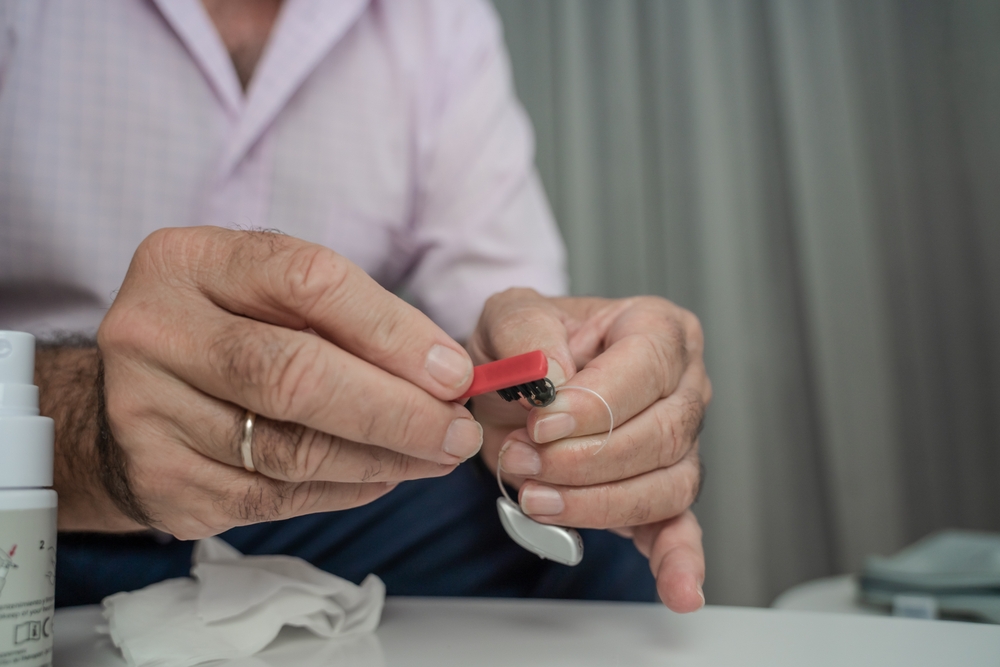Once you’ve adjusted to life with your hearing aid, it becomes an indispensable part of your day-to-day regimen. The likelihood of a breakdown can be worrysome, as it presents not only a disruption to everyday life, but also a considerable monetary burden in the form of repair or replacement costs.
How to best take care of your hearing aid
Understanding what can damage your hearing aid and learning how to care for it effectively will help you maintain its functionality and ensure it continues to enhance your quality of life.
Practical care of batteries
Your hearing aid’s functionality is heavily dependent on its battery. As a result, selecting the correct batteries for your hearing aid is essential. Consult with your hearing specialist to figure out the best battery variety for your model.
Handling the batteries with care is equally important. The natural oils, dirt, and moisture on your skin can pass on to the batteries and cause contamination, jeopardizing their performance and potentially leading to damage.
Prior to switching out the battery, ensure your hands are clean and totally dry to prevent any moisture from getting into the device.
Adhere closely to the manufacturer’s directions, particularly pertaining to battery upkeep. To prolong the battery life of your hearing aid, make sure to power it off when not using it and keep it stored in a safe , dry spot. Familiarizing yourself with the battery’s typical lifespan is also helpful.
Mark on your calendar when you change the battery, so you can prepare for when it needs to be replaced. It’s crucial to have a fresh battery with you at all times, specifically when you are not at home, in order to prevent being stuck without power all of a sudden.
Protect against moisture
As electronic devices, hearing aids are vulnerable to moisture. Even nominal exposure can lead to damage or a total breakdown of the device. To protect your hearing aid, think about purchasing a dehumidifier designed specifically for hearing aids. This unit provides a secure and dry atmosphere for your hearing aid when not in use, protecting it from damage related to unwanted moisture.
To safeguard your hearing aid from moisture damage, it’s a good plan to take it out before participating in activities that make you perspire heavily. However, consult your hearing specialist first, as removing your hearing aid during exercise, especially outdoors, may pose safety risks by limiting your ability to hear environmental sounds like traffic or alarms. If possible, opt to work out indoors where it is safer to remove your hearing aid, and make sure to remove your device before showering or swimming.
Furthermore, it is suggested to avoid using spray deodorants, hairspray, and any other aerosol products when your hearing aid is in use. These products contain moisture and chemicals that can accumulate on the device, leading to long-term damage. Apply these products before putting on your hearing aid to decrease exposure.
Control earwax buildup
While earwax serves as a natural shield, shielding your ears from debris, dirt, and tiny insects, it can also hamper the proper functioning of your hearing aid. Earwax can accumulate in the device, causing it to malfunction. For proper maintenance, schedule an appointment with your audiologist or doctor to evaluate the amount of earwax accumulation and establish a personalized cleaning plan tailored to your ears and hearing device.
Cleaning your ears safely is essential– never insert foreign objects into your ear canal. Instead of that, let warm water enter your ears while you shower. This can help in losening up and eliminating some of the earwax. Regular professional ear cleaning is also advisable. While this may seem inconvenient, it’s significantly less problematic than managing a malfunctioning hearing aid dued to excessive earwax.
When it comes to cleaning your hearing aid, follow the manufacturer’s instructions carefully.
Different types of hearing aids may require different cleaning techniques, and using the wrong method could cause harm to your device. If you’re unsure about the proper cleaning method, consult your hearing specialist or hearing aid provider to ensure you’re taking the correct steps to protect your device from earwax damage.
Simple steps for long-term dependability
Once you get used to wearing your hearing aids, they become a crucial aspect of your daily routine, making it difficult to envision life without them. By implementing a few simple safety strategies, you can safeguard your hearing aids from damage and preserve their reliability over the long term. Prioritize routine maintenance, store them safely, and handle them with care, ensuring you can continue to reap the benefits of improved communication and a more satisfying lifestyle.
If you are having problems with your hearing aid or need to schedule a routine maintenance appointment, please arrange for a visit.

